NASA has canceled all space shuttle flights to service the Hubble Space Telescope, which has provided revolutionary astronomy data and photographs. The decision was influenced by President Bush’s new space initiative, which called for the space shuttle to be retired by 2010. Without a servicing mission, Hubble will continue to degrade over time, lasting at least until 2007 or 2008. When it finally does stop functioning, NASA will launch a robot thruster to de-orbit the school bus-sized observatory safely.
Space Advocates Feel the Bush Plan Needs Work

Image credit: NASA
Although they appreciated President Bush’s new space initiative, many space advocacy groups were a little disappointed that this return to the Moon will probably be fashioned in the same mold as previous NASA projects, such as the space shuttle and the International Space Station. The groups, such as the Space Frontier Foundation, believe that NASA should be restructured to involve the private sector at all levels, to “let NASA do the exploring, but leave the operations to those who do such things best ? American industry”.
The Space Frontier Foundation today applauded President George W. Bush’s unveiling of a plan to get NASA out of Earth orbit and on a path to the Moon and Mars, but the group said that unless there are major changes at the agency and in U.S. space policy ? including the private sector in a leadership role for example ? the plan will fail.
?It was an excellent speech, very inspiring, and if we can do the things the president listed, then we will be on a path to the stars,? said Rick Tumlinson of the Foundation, who was invited by the White House to attend the speech. ?Unfortunately the NASA of today can’t do what the president has asked of it within a reasonable budget, in a reasonable time and in a way that leads to permanent human expansion beyond the Earth.?
The Foundation believes that NASA must be radically re-structured and it must learn new ways of doing business if it is to succeed in accomplishing the President’s vision. The group is calling on the government to include the private sector in all levels of the program’s planning and development as a way to dramatically lower costs, and assure permanence once the Moon base is established. Examples include: buying payload services from new U.S. space transportation firms; the establishment of prizes to be awarded for certain activities and technological milestones; and for private companies to build and operate the long term habitats that will be needed after the initial base camps are established by government astronauts.
?If America is going to reach for the Moon and Mars, we should do it in an American way, by creating a true partnership between the public and private sectors,? said Tumlinson. ?Let NASA do the exploring, but leave the operations to those who do such things best ? American industry. Federal Express, Hilton, Southwest Airlines and their competitors have driven costs down while improving services on Earth, so let’s let them or their space equivalents do the same in space. It isn’t all rocket science.?
The Foundation is glad to see that NASA will be ?leaving Earth orbit? as the President declared, and is hopeful that this means the government will support the development of space businesses such as commercial space flight, space hotels and industrial research in the Near Frontier around the Earth by clearing away regulatory barriers and creating tax incentives and space enterprise zones to encourage investment. The organization believes that if this initiative is to really be the first step to the human settlement of space, it has to eventually pay for itself. Thus, the government should build towards that goal from the beginning.
?I was glad to hear the President say that ?human beings are headed into the cosmos,? but so far that has meant mainly government employees traveling on government vehicles to government buildings. If this is to succeed, we need to begin blazing a trail that can be eventually be taken by anyone who wants to go,? said Tumlinson. ?The government should handle exploration and science ?out there? and the private sector should handle business and entertainment in space. Together we really can open the ?Space Frontier? of which the President spoke.?
To help build this new alliance for the frontier, the Foundation will be holding its 5th Return to the Moon Conference in Las Vegas in July. The conference will be held July 16-18 and will include attendees from government and the private sector. Registration for the conference is at: https://www.space-frontier.org/Events/RTM5/.
Original Source: Space Frontier Foundation News Release
Getting Closer to Saturn
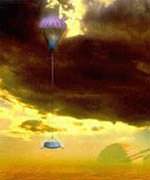
Image credit: ESA
NASA’s Cassini spacecraft is on track to reach Saturn in summer 2004. Before it reaches Saturn, however, the spacecraft will release a tiny probe called Huygens that will parachute into Titan, Saturn’s largest moon, to give scientists an idea of what’s underneath those thick clouds. Astronomers think that the environment on Titan is very similar to primordial conditions here on planet Earth billions of years ago. Huygens will take more than a thousand pictures and countless samples as it travels down to the surface in January 2005.
This time next year, ESA?s Huygens spaceprobe will be descending through the atmosphere of Saturn?s largest moon, becoming the first spacecraft to land on a body in the outer Solar System.
Earlier this month, the giant ringed planet Saturn was closer to Earth than it will be for the next thirty years. All the planets orbit the Sun as if on a giant racetrack, travelling in the same direction but in different lanes.
Those in the outer lanes have further to travel than those on the inside lanes. So, Earth regularly ?laps? the further planets. On New Year?s Eve 2003, Earth overtook Saturn, drawing closer than at any time in the next three decades.
Through a small telescope, Saturn is normally visible as a creamy yellow ?star?. You may be able to see the ring system that the planet is famous for, and its largest moon Titan will show up as a tiny dot of light.
That tiny dot is the destination for ESA?s Huygens probe and may hold vital clues about how life began on Earth. Titan is the only moon with a thick atmosphere in the Solar System.
Astronomers think this atmosphere might closely match the one Earth possessed millions of years ago, before life began. Certainly Titan?s atmosphere is rich in carbon, the chemical necessary for life on Earth. What is more, this is all stored in ?deep freeze?, ten times further from the Sun than the Earth.
The big mystery is Titan?s surface, which is hidden by a cloud layer. This is why ESA built Huygens, to probe through this layer which is impenetrable by Earth-based observations.
In January 2005, Huygens will parachute below the clouds to see what is really going on. Its battery of instruments will return over 1000 images as it floats down and samples the chemistry of this exotic place.
The Titan probe was named Huygens in honour of the Dutch astronomer who discovered Titan in 1655. Launched in October 1997, Huygens is currently in space, hitching a ride on NASA?s Cassini spacecraft.
So look forward to seeing more of Saturn and a tiny European spacecraft called Huygens, that in one year?s time will make an historic landing in the quest to uncover the origins of life.
Original Source: ESA News Release
Evidence that Brown Dwarfs are Failed Stars
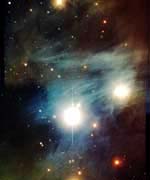
Image credit: UofM
Researchers from the University of Michigan have gathered evidence that brown dwarf stars have a very similar life to the early stages our own Sun went through when it first formed. The astronomers searched for dusty disks around young brown dwarfs by observing their infrared emissions. They found that most brown dwarfs did have disks at a million years old, which is very similar to young stars at the same age. Other observations showed that they accrete material from the disk in the same way stars do as well.
In cosmic circles, brown dwarfs are something of a flop. Too big to be considered true planets, yet not massive enough to be stars, these free-floating celestial bodies are, in fact, sometimes referred to as failed stars. But do they really form as stars do?from collapsing clouds of gas?or are their origins completely different? A series of publications by University of Michigan astronomer Ray Jayawardhana and collaborators, including a paper in the January 16 issue of Science, offers evidence that brown dwarfs and Sun-like stars are born in much the same way. “They at least have very similar infancies, which may mean that they also have very similar origins,” said Jayawardhana, an assistant professor of astronomy.
Stars form in cold clouds of gas and dust in interstellar space. Dense clumps within these clouds contract under their own gravity, spinning up in the process and gathering material from the surroundings into a disk. Eventually, if a growing protostar accumulates enough mass, its core becomes hot and dense enough for nuclear fusion to occur, and the new star begins to shine. Some scientists have suggested that brown dwarfs form the same way but simply don’t accumulate enough mass to ignite hydrogen fusion, and calculations show that it’s at least theoretically possible for objects with masses as low as those of brown dwarfs to be born this way.
But other scientists have proposed that brown dwarfs are runts kicked out of stellar litters. In this scenario, brown dwarfs are born in multiple star systems and compete with their siblings for matter from the natal cloud. In such systems, the slowest-growing object may be ejected before it gathers enough material to become a star, computer simulations suggest.
One way to distinguish between the two possibilities is by studying disks of dust and gas around young brown dwarfs. If brown dwarfs form as stars do, they should have large, long-lived accretion disks like those found around young stars. But if they have been ejected from multiple star systems, their disks should be shaved down by the gravitational interactions that lead to ejection.
Jayawardhana and colleagues searched for dusty disks around young brown dwarfs by observing their infrared emission with the 8-meter Very Large Telescope (VLT) of the European Southern Observatory in Chile and the 10-meter Keck I telescope in Hawaii. Because dust particles in a disk absorb light and re-radiate the energy at infrared wavelengths, a brown dwarf with a disk will emit more infrared light than one without a disk.
“We found that the majority of brown dwarfs are surrounded by dusty disks at an age of a million years or so,” said Jayawardhana. “That’s similar to young stars at the same age.” Although it’s not possible to directly determine the disks’ sizes, their presence around some brown dwarfs as old as 10 million years suggests that they aren’t pared away in early life.
Other spectroscopic observations, using the twin 6.5-meter Magellan telescopes in Chile (in which the University of Michigan is a partner institution) and the Keck I telescope, showed that brown dwarfs also accrete material from surrounding disks the same way as stars do?although at a slower pace. “We detect telltale signs of gas flowing from the inner edge of the disk onto the brown dwarf at velocities of over a hundred kilometers per second,” said Jayawardhana. In one intriguing case, astronomers have alsofound evidence of material spewing out from the poles of a brown dwarf. Such jets have been seen in young stars of the same age, but not until now in brown dwarfs. “If confirmed, the presence of jets would further strengthen the case for remarkably similar infancies for brown dwarfs and Sun-like stars,” said Jayawardhana, whose collaborators include Subhanjoy Mohanty (Harvard-Smithsonian Center for Astrophysics), Gibor Basri (University of California, Berkeley), David Barrado y Navascues (Laboratory of Space Astrophysics and Fundamental Physics in Madrid, Spain), David Ardila (Johns Hopkins University), Beate Stelzer (Astronomical Observatory of Palermo in Italy), and Karl Haisch, Jr. and Diane Paulson (both at the University of Michigan).
“I wouldn’t say that the story is signed, sealed and delivered,” Jayawardhana said, “but the preponderance of evidence is very much leaning in the direction of these things forming the same way as stars.” And the evidence uncovered so far leads to even more tantalizing prospects. “Now that we know many young brown dwarfs are surrounded by disks,” he said, “I can’t help but wonder if comets and asteroids?if not small planets?could form in these disks.”
This research was supported primarily by a grant from the National Science Foundation.
Original Source: University of Michigan News Release
NASA Reorganizes to Support Bush Strategy
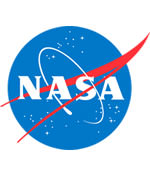
Image credit: NASA
NASA announced on Thursday that it would be reorganizing aspects of the agency to better support the new vision of space exploration laid out by George Bush earlier in the week. The Office of Exploration Systems was created, and will be led by Craig Steidle to build the equipment that will take humans back to the Moon. A special committee was appointed by the President, and is expected to deliver a more concrete plan for the space initiative within four months.
In a move designed to align the agency with the new exploration agenda outlined yesterday by President George W. Bush, NASA Deputy Administrator Frederick D. Gregory announced a comprehensive restructuring of the offices within Headquarters in Washington.
The alignment impacts NASA management, the strategic Enterprises, and the agency’s functional offices. The new alignment goes into effect immediately and reflects the new vision and the results of a comprehensive review of Headquarters operations, which first began when Gregory became Deputy Administrator in 2002.
Retired U.S. Navy Rear Admiral Craig E. Steidle is the new Associate Administrator, Office of Exploration Systems. Since retiring from the Navy in March, 2000, he has been an independent aerospace consultant. He was Chief Aerospace Engineer and Vice Commander, Naval Air Systems Command, which develops, acquires and supports naval aeronautical systems, when he retired.
The Office of Exploration Systems is established to set priorities and direct the identification, development, and validation of exploration systems and related technologies. Users and technologists will work together to enable a balancing of factors between requirements, program schedules and costs.
Steidle entered the Navy after graduating with merit from the United States Naval Academy, Annapolis, Md. He trained as an attack pilot, test pilot and test pilot instructor. Steidle commanded the Navy’s F/A-18 Program, naval aviation’s largest production, research and development program, as well as the largest Foreign Military Sales Program. The Secretary of Defense presented Steidle with the Navy’s Outstanding Program Manager Award. While Director of the Joint Strike Fighter Program, the program was awarded the David Packard Excellence in Acquisition Award.
Steidle earned Master of Science degrees in Systems Management and Aerospace Engineering. He is a member of the Society of Experimental Test Pilots and is a Fellow of the Royal Aeronautical Society.
Dr. J. Victor Lebacqz is the new Associate Administrator, Office of Aeronautics, which was previously known as the Office of Aerospace Technology. He has served as Acting Associate Administrator of the Office of Aerospace Technology since July 2003. He was appointed as Deputy Associate Administrator in December 2002.
The new Office of Aeronautics was created to reflect NASA’s commitment to aviation research and aeronautics technologies for the nation’s civil and defense interests.
“This alignment gives us the ability to specifically focus on our aeronautics and exploration systems,” Gregory said. “These management adjustments will give us new opportunities for more effective leadership, policy and program success.”
The changes are consistent with NASA’s ongoing responses to the management and cultural issues addressed by the Columbia Accident Investigation Board. “We live in a different world than we did just a few years ago, and our management structure should reflect the priorities and objectives of our commitments,” Gregory added.
The Office of the NASA Administrator will be streamlined to allow for more independent leadership in areas vital to the execution of NASA’s vision and mission. Among the changes, three new independent offices will be created.
The new offices include:
* The Office of Chief Engineer is established to ensure agency development efforts and mission operations are planned and conducted using sound engineering
* The Office of Health and Medical Systems is established to ensure the well-being of the NASA workforce and to provide independent oversight authority for healthcare, related research and information
* The Office of the Chief Information Officer is established to manage the agency’s Information Technology (IT) investments, lead the development of an IT strategic plan, and create a roadmap to guide the agency’s IT programs and policies.
* The Office of Institutional and Corporate Management (Code O) is established to lead the oversight of NASA’s management systems, institutional, and corporate activities
Leadership for the new offices, as well as staffing requirements and resource allocations, will be addressed as the new alignment is implemented this calendar year.
For additional information about NASA and management programs on the Internet, visit:
Original Source: NASA News Release
Scientists Could Choose More Dangerous Targets on Mars
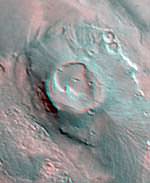
Image credit: NASA/JPL
If the next Mars Exploration Rover, Opportunity, is as successful as Spirit, then engineers might loosen up a bit and send rovers to more dangerous locations on Mars. Selecting landing sites on Mars is a difficult job; you need to balance the scientific payoff with the chance of losing the rover when it first arrives at Mars. If the terrain is too rocky, the rover could be destroyed before the mission even begins. One possible target for a future mission is near a volcano called Apollinaris Patera, which could have kept water liquid – a potential home for life.
The anticipated Mars landing on Jan. 24 of the Opportunity rover will be a bit more challenging than the Spirit’s bounce onto the red planet earlier this month, according to a University at Buffalo geologist, but if it’s successful, then scientists will be able to be much bolder about selecting future Mars landing sites.
“If both of these landers survive with airbag technology, then it blows the doors wide open for future Mars landing sites with far more interesting terrain,” said Tracy Gregg, Ph.D., University at Buffalo assistant professor of geology in the UB College of Arts and Sciences and a planetary volcanologist.
Gregg, who headed a national conference at UB in 1999 regarding the selection of future Mars landing sites, is chair of the geologic mapping standards committee of the NASA Planetary Cartography Working Group.
“With the success of Spirit, I feel so much more confident about future Mars landers,” said Gregg. “The airbags seem to be able to withstand quite a bit of trauma.”
Gregg remembers attending a conference presentation a few years ago by Matt P. Golombek, Ph.D., planetary geologist at the Jet Propulsion Laboratory and, at the time, the principal investigator on the Mars Pathfinder mission, in which he proposed the airbag landing technology.
“He listed the 15 steps that had to happen at exactly the right time and in exactly the right way in order for this technology to work. The general mood in the lecture hall was, ‘Yeah, right, good luck,'” Gregg remembered. “Well, the next year, he got up to a standing-room-only crowd at a meeting of the same organization and he described all of the same steps that the Pathfinder had successfully completed on Mars. He got a standing ovation.”
The selection of Mars landing sites is a complex balancing act, Gregg says, where the potential for important scientific discoveries has to be balanced against the requirement that sites be absolutely safe so that the rovers can perform well and send data back to earth.
Both Gusev Crater, where the Spirit landed, and Sinus Meridiani, where Opportunity is scheduled to land, were chosen, Gregg says, because they are not expected to have large boulders, steep cliffs or deep craters that could pop an airbag or swallow up the lander preventing the transmission of radio signals.
“If Opportunity survives the landing on Jan. 24, there is a high possibility that we will get to see layers of ancient rock, deposited when Mars was warm and wet and could have supported life,” she says. “Evidence of river channels, which we expect to see at Sinus Meridiani, could be remnants of that early, warm history.”
When pictures start coming back from Opportunity, Gregg will have her eyes peeled, searching for layers in the walls of the dried-up river channels.
“Those layers could be lava flows,” explained Gregg, noting that often the best place to look for evidence of life on any planet is near volcanoes.
“That may sound counterintuitive, but think about Yellowstone National Park, which really is nothing but a huge volcano,” she says. “Even when the weather in Wyoming is 20 below zero, all the geysers, which are fed by volcanic heat, are swarming with bacteria and all kinds of happy little things cruising around in the water.
“So, since we think that the necessary ingredients for life on earth were water and heat, we are looking for the same things on Mars, and while we definitely have evidence of water there, we still are looking for a source of heat.”
Gregg hopes that a future landing Mars site will be near a volcano, particularly one called Apollinaris Patera.
“A landing site near a volcano might be possible, now that the airbag technology has worked so wonderfully,” she says.
Original Source: University of Buffalo News Release
Mini-Van Sized Rover for 2009
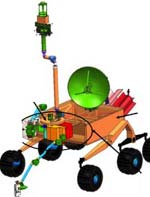
Image credit: NASA
Pathfinder was the size of a shoebox; the Mars Exploration Rovers are as big as golf-carts; but a future Martian rover could be as big as a mini-van. Engineers from Montana State University are helping to design the Mars Scientific Laboratory (MSL), which could make its way to the Red Planet by 2009. Unlike Spirit and Opportunity, which are solar powered, the MSL will have a nuclear reactor, so it will be able to remain operational on the surface for an entire Martian year (two years on Earth), and measure long-term climate changes.
If you think the Mars rovers are interesting, wait until you see a mini-van clambering over the planet’s red rocks and dusty lake beds.
The two golf-cart size rovers that are mesmerizing the country now are preparing the way for a 2009 mission to Mars called the Mars Scientific Laboratory, says William Hiscock, head of the physics department and director of the Montana Space Grant Consortium based at Montana State University-Bozeman. The 2009 mission will involve a rover, too, but that vehicle will be the size of a mini-van.
Lest anyone picture adventurous soccer parents doubling as astronauts, Hiscock said the upcoming rover, like the Spirit and Opportunity rovers, will be remotely controlled. It will be nuclear powered instead of solar powered.
Nuclear power is a good thing, because it means the rover won’t be disabled by dust covering the power source, Hiscock said. The current rovers are expected to run 90 days before they’re done in by conditions like dust or extreme temperature changes.
“Dust builds up on solar panels, decreasing the light getting in. The power fades away because of it,” Hiscock explained.
Roving around Mars is like being 100,000 feet above sea level on Earth, Hiscock added. So when day turns into night, temperatures can drop up to 200 degrees, only to surge again the next day.
“That puts a lot of thermal stress on electronics and wiring,” Hiscock said. “Eventually probably, something just breaks after going through so many cycles.”
The Sojourner rover that landed on Mars in 1997 and still sets on the planet was disabled by dust and extreme temperatures, Hiscock said. It weighed 23 pounds, which means the Spirit and Opportunity are almost big enough to roll over it. The two rovers each weigh about 400 pounds.
Michelle Larson, deputy director of the Montana Space Grant Consortium, said the larger size of the 2009 rover will give it the ability to survive longer than current and past rovers.
“Therefore, science experiments performed on the 2009 rover will be able to make long duration measurements to see how the environment changes in time,” Larson said. “The intent is to have the science instruments on the rover operating for an entire Martian year (which is approximately two Earth years).”
The 2009 mission will investigate the capacity of the Mars environment to sustain life, Larson said. Among other things, the mission will look for organic carbon compounds and features that might have resulted from biological processes. The mission will look at the geology and geochemistry of the landing area, investigate the role of water and other processes that may have been relevant to past living conditions. The mission will look at the effects of cosmic and solar radiation on the Martian surface.
Original Source: Montana State University News Release
Martian Gravity To Be Tested on Mice
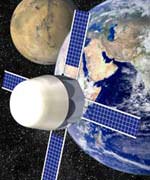
Image credit: MIT
Researchers from MIT are planning to test the effects of Martian gravity on mammals, by sending 15 mice into orbit for five weeks. The mice would be launched aboard a one-metre “spaceship”, which would be spun so that the force mimics the gravity on Mars. Scientist know that weightlessness causes health problems, including bone loss, but human travelers to Mars could stay for months or even years in a permanent outpost – it’s critical to know if the human body can handle it. If all goes well, the mission could launch in 2006.
Students and researchers at MIT are designing a space mission to learn about the effects of Mars-level gravity using pint-sized astronauts.
The 15 mouse-trounauts will orbit Earth for five weeks to help researchers learn how Martian gravity – about one-third that of Earth – will affect the mammalian body.
The goal of the Mars Gravity Biosatellite Program is to send the mice into near-Earth orbit inside a one-meter space ship simulating Mars’ gravity, then bring them back to Earth. It won’t be the first time mice have flown in space, but it will be the first time mammals of any kind have lived in partial gravity for an extended period. The spin of the spacecraft will create an effect on the mice equivalent to Mars’ gravity.
The mouse cages will be designed for comfort and protection with room for the little travelers to lope around for exercise in the simulated gravity of Mars.
“Astronauts living on space stations have encountered serious health problems such as bone loss due to their weightless environment [zero gravity],? the team said in a statement. “The first crew on Mars could experience similar effects; scientists do not yet know whether partial gravity is sufficient to prevent these health hazards. A crew of mice will provide the first answers.?
The multi-university group, led by MIT and involving the University of Washington at Seattle and the University of Queensland in Brisbane, Australia, is managed by MIT research affiliate Paul Wooster (MIT S.B. 2003).
The MIT team is providing overall systems engineering and project management, as well as designing and building the payload module, and planning the scientific experiments. Students and researchers from Washington are designing and building the spacecraft bus, which contains the power, propulsion and communications components. Re-entry and recovery systems are the responsibility of the Australian group.
The project is expected to cost about $15 million plus the cost of the launch. The teams have received more than $400,000 for building the spacecraft from a variety of sources including NASA, the three universities, and a number of private companies and individuals. The teams have also secured commitments to cover approximately half the cost of the $6 million launch.
The program is overseen by a program board composed of faculty from each of the universities and outside space experts, and supported by a broad network of advisors from the space field. Given appropriate funding, the mission could launch as early as mid-2006.
For more information on the Mars Gravity Biosatellite, visit http://www.marsgravity.org.
Original Source: MIT News Release
Spirit Rolls Off the Lander
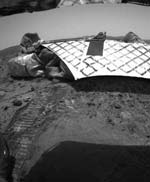
Image credit: NASA/JPL
NASA’s Spirit rover successfully rolled off the landing platform and out onto the Martian surface this morning, beginning its mission of exploration. The rover traveled 3 meters in 78 seconds, and it ended up about 80 centimetres away from the lander. Now that Spirit’s firmly on the ground, NASA scientists and engineers will make daily decisions about what science tasks it will perform, and where it will travel. Spirit’s twin rover, Opportunity, will arrive on Mars on January 25 to explore another region on the other side of the planet.
NASA’s Mars Exploration Rover Spirit successfully drove off its lander platform and onto the soil of Mars early today.
The robot’s first picture looking back at the now-empty lander and showing wheel tracks in the soil set off cheers from the robot’s flight team at NASA’s Jet Propulsion Laboratory, Pasadena, Calif.
“Spirit is now ready to start its mission of exploration and discovery. We have six wheels in the dirt,” said JPL Director Dr. Charles Elachi.
Since Spirit landed inside Mars’ Gusev Crater on Jan. 3 (PST and EST; Jan. 4 Universal Time), JPL engineers have put it through a careful sequence of unfolding, standing up, checking its surroundings and other steps leading up to today’s drive-off.
“It has taken an incredible effort by an incredible group of people,” said Mars Exploration Rover Project Manager Peter Theisinger of JPL.
The drive moved Spirit 3 meters (10 feet) in 78 seconds, ending with the back of the rover about 80 centimeters (2.6 feet) away from the foot of the egress ramp, said JPL’s Joel Krajewski, leader of the team that developed the sequence of events from landing to drive- off. The flight time sent the command for the drive-off at 12:21 a.m. PST today and received data confirming the event at 1:53 a.m. PST. The data showed that the rover completed the drive-off at 08:41 Universal Time (12:41 a.m. PST).
“There was a great sigh of relief from me,” said JPL’s Kevin Burke, lead mechanical engineer for the drive-off. “We are now on the surface of Mars.”
With the rover on the ground, an international team of scientists assembled at JPL will be making daily decisions about how to use the rover for examining rocks, soils and atmosphere with a suite of scientific instruments onboard.
“Now, we are the mission that we all envisioned three-and-a-half years ago, and that’s tremendously exciting,” said JPL’s Jennifer Trosper, mission manager.
JPL engineer Chris Lewicki, flight director, said “It’s as if we get to drive a nice sports car, but in the end we’re just the valets who bring it around to the front and give the keys to the science team.”
Spirit was launched from Cape Canaveral Air Force Station, Fla., on June 10, 2003. Now that it is on Mars, its task is to spend the rest of its mission exploring for clues in rocks and soil about whether the past environment in Gusev Crater was ever watery and suitable to sustain life. Spirit’s twin Mars Exploration Rover, Opportunity, will reach Mars on Jan. 25 (EST and Universal Time; 9:05 p.m., Jan. 24, PST) to begin a similar examination of a site on the opposite side of the planet.
JPL, a division of the California Institute of Technology in Pasadena, manages the Mars Exploration Rover project for NASA’s Office of Space Science, Washington, D.C. Images and additional information about the project are available from JPL at http://marsrovers.jpl.nasa.gov and from Cornell University, Ithaca, N.Y., at http://athena.cornell.edu.
Spitzer Image of the Tarantula Nebula
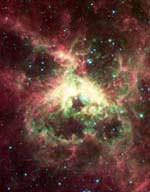
Image credit: NASA/JPL
The latest image from the Spitzer Space Telescope is of often-photographed Tarantula Nebula. Spitzer, however, is able to pierce through the dust and material that surrounds the nebula to take a good look inside this active star-forming region. This new photograph has turned up previously hidden stars inside the nebula, as well as empty cavities of space around them – their powerful radiation blows all the dust away. Images like this will help astronomers understand the environments that form stars and get a better sense of where our own Solar System came from.
A dusty stellar nursery shines brightly in a new image from NASA’s Spitzer Space Telescope, formerly known as the Space Infrared Telescope Facility. Spitzer’s heat-sensing “infrared eyes” have pierced the veiled core of the Tarantula Nebula to provide an unprecedented peek at massive newborn stars.
The new image is available online at http://www.spitzer.caltech.edu and http://photojournal.jpl.nasa.gov/catalog/PIA05062.
“We can now see the details of what’s going on inside this active star-forming region,” said Dr. Bernhard Brandl, principal investigator for the latest observations and an astronomer at both Cornell University, Ithaca, N.Y., and the University of Leiden, the Netherlands.
Launched on August 25, 2003, from Cape Canaveral Air Force Station, Florida, the Spitzer Space Telescope is the fourth of NASA’s Great Observatories, a program that also includes Compton Gamma Ray Observatory, the Chandra X-ray Observatory and the Hubble Space Telescope. Spitzer’s state-of-the-art infrared detectors can sense the infrared radiation, or heat, from the farthest, coldest and dustiest objects in the universe.
One such dusty object is the Tarantula Nebula. Located in the southern constellation of Dorado, in a nearby galaxy called the Large Magellanic Cloud, this glowing cloud of gas and dust is one of the most dynamic star-forming regions in our local group of galaxies. It harbors some of the most massive stars in the universe, up to 100 times more massive than our own Sun, and is the only nebula outside our galaxy visible to the naked eye.
While other telescopes have highlighted the nebula’s spidery filaments and its star-studded core, none was capable of fully penetrating its dust-enshrouded pockets of younger stars.
The new Spitzer image shows, for the first time, a more complete picture of this huge stellar nursery, including previously hidden stars. The image also captures in stunning detail a hollow cavity around the stars, where intense radiation has blown away cosmic dust.
“You can see a hole in the cloud as if a giant hair dryer blew away all the gas and dust,” said Brandl.
By studying this portrait of a family of stars, astronomers can piece together how stars in general, including those like our Sun, form.
JPL manages the Spitzer Space Telescope mission for NASA’s Office of Space Science, Washington. Science operations are conducted at the Spitzer Science Center at the California Institute of Technology in Pasadena. JPL is a division of Caltech.
Additional information about the Spitzer Space Telescope is available at http://www.spitzer.caltech.edu.
Original Source: NASA/JPL News Release
